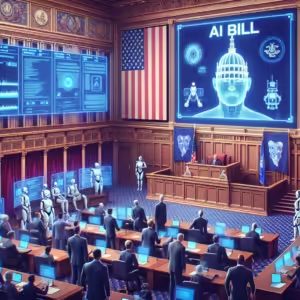Understanding the Role of Artificial Intelligence in Judicial Systems
The integration of artificial intelligence (AI) into judicial systems has been heralded as a transformative force capable of modernizing courtroom processes and enhancing decision-making efficiency. However, while the potential benefits are considerable, it is crucial to acknowledge and explore the risks associated with AI adoption in such a sensitive domain.
The Rise of Artificial Intelligence in Courts
Courts around the world are increasingly experimenting with AI technologies to improve the management of legal cases and the delivery of just outcomes. These technologies can range from **predictive analytics** and legal research tools to AI-driven voice recognition systems that transcribe court proceedings.
Such advancements have the potential to revolutionize the legal field by increasing efficiency and reducing costs. However, they also introduce a new set of challenges and risks that need to be meticulously addressed.
Potential Risks Associated with AI in Judicial Systems
While AI technologies promise to enhance judicial proceedings, they also bring several risks. Ignoring these risks could undermine public trust in legal systems. Here we explore some of the critical concerns surrounding AI deployment in courts.
Bias and Fairness Concerns
One of the most significant risks associated with AI is its potential to perpetuate or even exacerbate existing biases. AI systems learn from historical data, which might include **biased information**. If such biases are not identified and mitigated, AI could lead to unfair outcomes, particularly affecting marginalized communities.
Addressing these biases requires a deliberate effort in training and regular auditing of AI systems to ensure fairness and impartiality in judicial outcomes.
Lack of Transparency
The decision-making processes of AI systems can often be complex and opaque, creating a “black box” scenario. This lack of transparency makes it challenging for stakeholders – including judges, lawyers, and the public – to understand how decisions are made, raising concerns about accountability.
To overcome this, courts must prioritize **transparency** by employing AI systems with explainable algorithms and developing clear guidelines that dictate their application.
Privacy and Data Security Threats
AI systems require access to vast amounts of data, some of which may be sensitive or personal. This creates privacy and data security concerns, as the potential for unauthorized data exposure or misuse increases.
Implementing robust security measures and frameworks for data protection becomes indispensable to safeguard the privacy of individuals engaged in legal processes.
Ethical and Legal Implications of AI in Judicial Decision-Making
Introducing AI into judicial decision-making raises complex ethical questions about responsibility and accountability. As AI systems become more involved, it is essential to outline the ethical boundaries that these systems must operate within.
Human Oversight and Responsibility
AI should serve as an assistive tool rather than a replacement for human judgment. Legal professionals must retain ultimate responsibility for decisions, ensuring that they align with ethical standards and principles of justice.
Embedding human oversight in AI applications will help uphold the integrity of the judicial system and prevent potential miscarriages of justice.
Adapting Legal Frameworks
As AI continues to evolve, existing legal frameworks may need to be adapted to accommodate new technologies. This involves revisiting laws and regulations to ensure they adequately address the unique challenges posed by AI in the courtroom.
By proactively adapting legal frameworks, judicial systems can better manage potential risks and maximize the benefits of AI integration.
The Path Forward: Safeguarding Justice in the Age of AI
To harness the potential of AI while preserving justice and fairness, a multi-faceted approach is necessary. Policymakers, legal professionals, and technologists must collaborate to create an ecosystem where AI can flourish without compromising ethical standards.
Developing Standards for AI Implementation
Establishing comprehensive standards is crucial to guide the responsible deployment of AI in judicial systems. These standards should emphasize transparency, accountability, and impartiality, ensuring that AI enhances rather than hinders justice.
Continuous Monitoring and Evaluation
Ongoing monitoring and evaluation of AI systems are necessary to identify potential shortcomings and areas for improvement. This requires implementing mechanisms for regular auditing and feedback from stakeholders.
Education and Training for Legal Professionals
Educating and training legal professionals on AI technologies will prepare them to engage with these tools effectively. This includes understanding their capabilities, limitations, and ethical considerations.
In conclusion, the potential benefits of AI in judicial systems are vast, but they come with risks that must not be overlooked. By addressing these challenges through comprehensive standards, continuous evaluation, and vigorous education, the judicial system can navigate the complexities of AI without compromising integrity. This balanced approach will ensure that AI acts as a force for good, supporting justice and equality in legal proceedings.








